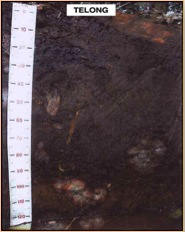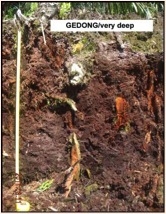Peat soils in their natural state are wet with very high water table near to the soil surface. They are also soft as they are organic (made up of mainly rotting plant materials) in nature. Thus, peat soils are also known as organic soils. Since peat soils are organic in nature, the bulk density is also low. The high water table and the soft nature of the soil make peat soils soggy and it is not easy to walk on an undrained peat soil without sinking down. As such, mapping virgin peat soil areas is not liked by many soil surveyors.
In Malaysia, virgin lowland peat areas are often flooded and swampy. Much of the peat areas were marked as swamp areas for this reason. They were left untouched and not used for farming. However, over the years, as development progressed, more and more mineral ( non organic) soils were used up and the borders of the peat swamps were reached. In some parts of Malaysia, particularly Sarawak, there is not much option as to what type of land to use as the state has large areas of its land mass as peat.
Farming is a major economic activity which has been successfully carried out on peatland in Malaysia; starting with planting of vegetables and cash crops such as pineapples and tapioca or cassava during the second half of the 20th century. Later, these soils were planted with rubber but the venture was not successful due to badly leaning trees which made the tapping of the trees to extract latex very difficult. The planting of sago palms and oil palms on peat soils were then tried and found to be economically feasible.
Tropical peat has not been well studied. As such, estimations of CO2 emissions are often extrapolated based on data from temperate peat. Thus, it is often doubted that this can be done since the factors of peat formation in temperate areas are different from that in tropical areas and the peat will be different morpho-genetically (Paramanathan,2008; Yew et al., 2010). Temperate peat deposits are also known to be derived from bryophytes and small shrubs while tropical peat deposits are derived from various tree species with root penetration up to several meters (Wust, 2003).
New information (Veloo et al., 2014 ) obtained from soil survey and soil classification research carried out in Sarawak, Malaysia is confirming that tropical peat soils are indeed different from temperate peat soils with many of the tropical peat soils containing wood materials in the soil solum.
Tropical peat materials, just like temperate peat materials can be differentiated based on the stage of decomposition. There are 3 stages of decomposition, namel
- sapric (very high stage of decomposition)
- hemic (moderate stage of decomposition) and
- fibric (low stage of decomposition)
Tropical peats are, however, different from temperate peat as wood is often present. When present, it may be in different stages of decomposition (Photos 1-3). There occurs a wide variety of tropical wood. This is well known since tropical wood ranges from hard, medium to soft wood. Thus, the break down or decay rate can vary depending on the types of wood present. Hard wood, for example, is very recalcitrant and can take a long time to break down and emit CO2 during the process.
As such sapric, hemic and fibric peat may also have the following wood fragments in the soil solum:-
- Without wood
- With decomposed wood
- With decomposing wood
- With undecomposed wood
Photo 1: Deep peat soil in Sarawak, Malaysia without wood.
(Photo courtesy of Ramesh Veloo)

Photo 2: Peat soil in Sarawak, Malaysia with decomposing wood .
(Photo courtesy of Ramesh Veloo)

Photo 3: Peat soil in Sarawak, Malaysia with undecomposed wood.
(Photo courtesy of Ramesh Veloo)

Cultivated tropical peat soils have lower CO2 emission than reported
CO2 is emitted when carbon rich peat soils are disturbed for cultivation. Such emissions have an effect on climate change and this needs to be properly addressed.
When peatland is drained for oil palm cultivation, break down of the peat materials releases CO2 into the atmosphere. Many publications on the CO2 emission on tropical peat extrapolate or use information from work carried out on temperate peat. Friends of the Earth (2008) estimated the CO2 emissions to be 70 tonnes ha-1year-1 under oil palm cultivation. This emission is 4.4 times larger than the emission reported in temperate and boreal peat, which is 15,944 tonnes ha-1year-1 (Oleszczuk, 2008). United States Environmental Protection Agency (EPA) has given a higher CO2 emission value of 95 tonnes ha-1year-1 based on the study of Hooijer et al. (2012) while IPCC (2014) gave a value of 40 tonnes ha-1year-1.
EPA carried out a peer review of the emission factor for tropical peatlands drained for oil palm cultivation and the findings were reported in December 2014. The results in Table 1 show the opinions of the five experts after their critical evaluations of the problems stated. There was no general consensus among them with regard to the amount of peat emission and this shows the complexity and the lack of information on tropical peat soils. Nevertheless, the results in Table 1 pointed to the fact that the CO2 emissions should range between 40 to 95 tonnes ha-1year-1. In the field, CO2 emissions on peatland cultivated with oil palm are found to be on the lower end. For example, Agus et al., (2013) found that the emission from peat oxidation under oil palm cultivation was 43 t CO2 ha-1year-1. Similarly, Melling et al.,(2007) found an emission of 41 t CO2 ha-1year-1 for young mature oil palm area, with root respiration included.
Table 1. Opinions from 5 experts on CO2 emissions in tropical peat drained for oil palm cultivation*
| Questions | Opinion | ||
| Fair value | Overestimate | Underestimate | |
| Choudhury et al. (1995) Is emission used by EPA of 95 tonnes ha-1year-1 a fair value?. | 1 | 2 | 2 |
| Choudhury et al. (1995) Is IPCC default emission of 40 tonnes ha-1 year-1 a fair value?. | 2 | 0 | 3 |
Source * EPA (2014) Based on the soil survey and mapping of a total of 700,000 hectares of lowland peat in Southeast Asia, the majority of them can be classified as Saprists (Paramanathan, personal communication). Thus, the majority of lowland peat soils in Malaysia are classified as Saprists under USDA Soil Taxonomy or as Histosols under FAO/UNESCO classification. Saprists have very highly decomposed peat materials as shown in Table 2. Thus, the amount of CO2 emission when the peat soil is drained is lower for one that has sapric instead of fibric material. A larger degree of breakdown quickly takes place in a soil with fibric materials when drained, resulting in higher CO2 emission. Table 2: Type of peat and expected CO2 emission when drained
| Nature of peat | Stage of decomposition of peat | Amount of CO2 emission when peat soil is drained |
| Sapric | Very high | Low |
| Hemic | Medium | Medium |
| Fibric | Low | High |
Secondly, many tropical peat soils, such as those in Sarawak, have wood fragments in the soil solum. Sometimes, they can occupy as much as 50% or more of the soil layers. When these peat soils are drained, the wood fragments do not decompose easily to add on to CO2 emission. Besides, when wood fragments are present, the amount of sapric, hemic or fibric organic soil materials which are decomposable are reduced. This reduces the CO2 emission even further when the peat soils are drained. The amount of drainage is another critical factor that determines CO2 emission; a higher emission is linked to deeper or more intense drainage. Most oil palm roots are concentrated in the top 50 cm of the peat soil. Oil palm plantations keep a high water table at 50-70 cm by following RSPO’s Best Management Practices for oil palm cultivation on peatland so as to obtain better yields.
Conclusions
Most of the publications on CO2 emission on drained tropical lowland peat soils have been extrapolated from experiences based on temperate peat. This has been a consequence of the general lack of information and experience with tropical peat. New evidence obtained from detailed soil surveys, mapping and classification shows that the majority of Malaysian lowland peat soils are mainly sapric and with many of them containing wood. Coupled with the fact that peat soils are not excessively drained when planted with oil palm, the cultivation of such soils have lower CO2 emissions than what is reported currently.
Literature cited
- Agus,F., Henson,I.E., Suhardjo,B.H., Harris,N., van Noordwijk,M., Killen,T.J. (2013). Review of emission factors for assessment of CO2 emission from land use change to oil palm in Southeast Asia. Technical Panel of the 2nd Greenhouse Gas Working Group of RSPO.
- EPA (United States Environmental Protection Agency). (2014). Peer review of the emission factor for tropical peatlands drained for palm oil cultivation. EPA-420-F-14-061.
- Friends of the Earth.(2008). Malaysian Palm Oil-Green Gold or Green Wash?
- Hooijer,A.,Page,S.,Jauhiainen,W.A.,Lee,X.X.,Idris,A.,Anshari,G.(2012). Subsidence and carbon loss in drained tropical peatlands. Biogeosciences 9: 1053-1071.
- IPCC (Intergovernmental Panel on Climate Change). (2014). 2013 supplement to the 2006 IPCC guidelines for national greenhouse gas inventories: Wetlands.
- Melling,L., Goh,K.J., Beauvais,C., Hatano,R. (2007). Carbon flow and budget in a young mature oil palm agroecosystem on deep tropical peat. IN Rieley,J.O., Banks,C.J., Radjagukguk,B.(Editors).Proceedings of the International Symposium and Workshop on Tropical Peatland, Yogyakarta, Indonesia.
- Oleszczuk,R., Regina,K., Szajdak,L., Hoper,H., Maryganova,V. (2008). Impacts of agricultural utilization of peat soils on the greenhouse gas balance IN Maria Streck (Editor): Peatlands and climate change, International Peat Society, 70-97.
- Paramananthan,S.(2010). Tropical lowland peats: to conserve or develop them. International Palm Oil Sustainability Conference.
- RSPO. (2012). RSPO manual on best management practices for existing oil palm cultivation on peat,pp214.
- Veloo,R.,Paramananthan,S., van Ranst,E. (2014), Classification of tropical lowland peats revisited: The case of Sarawak. Catena 118,179-185.
- Wust,R.A.J., Bustin,R.M., Lavkulich,L.M.(2003). New classification systems for tropical organic rich deposits based on studies of the Tasek Bera Basin, Malaysia, Catena 53,133-163.
- Yew, F.K., Sundram, K., Yusof, B. (2010). Estimation of GHG emissions from peat used for agriculture with special reference to oil palm. Jour. Oil Palm & The Environment 2010, 1,17-25.
Article credit: Yew Foong Kheong

